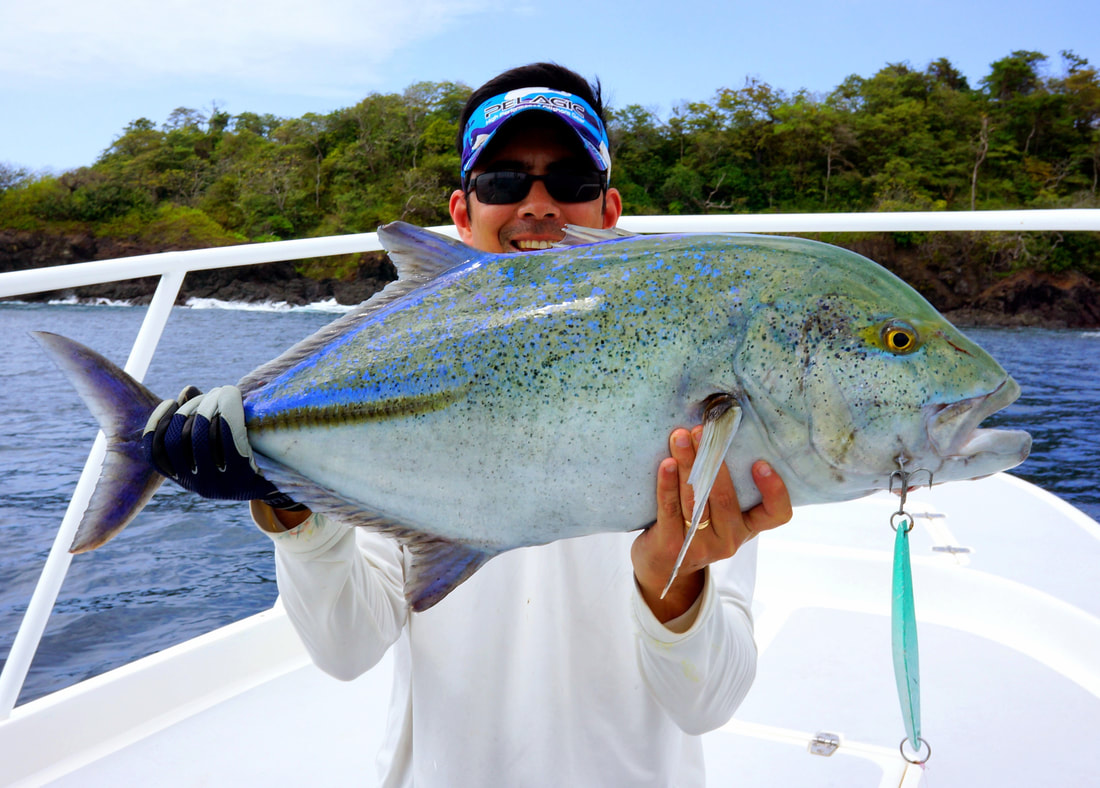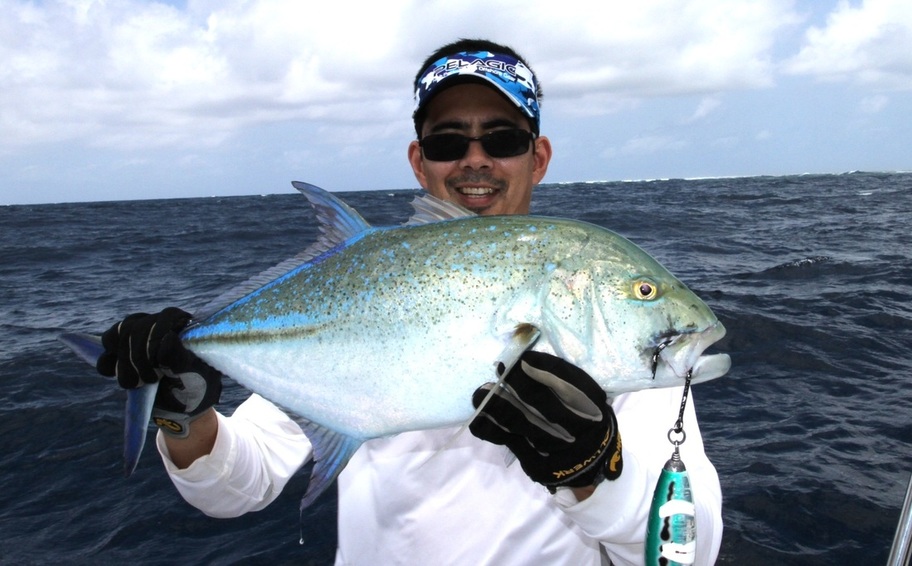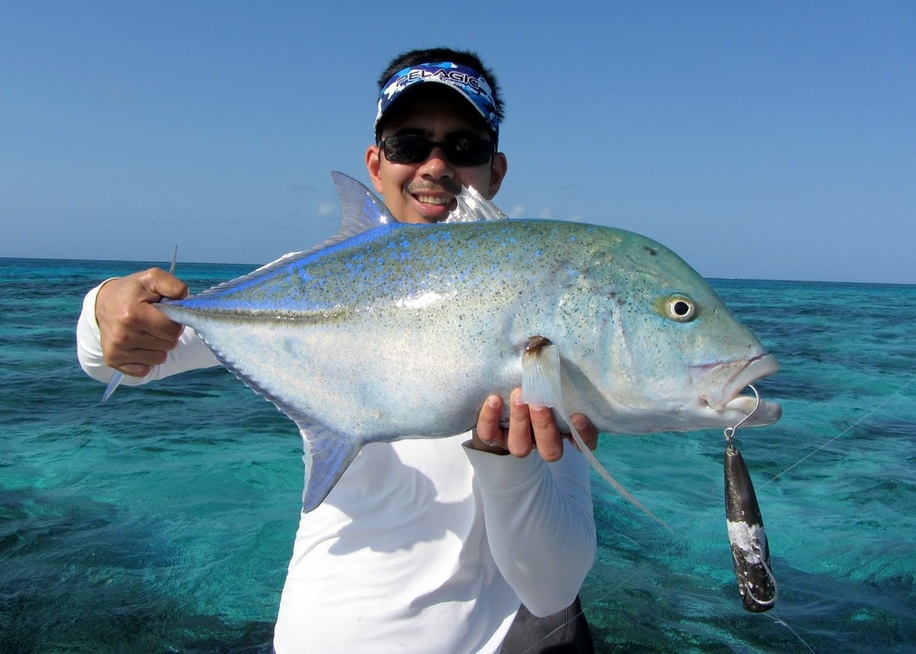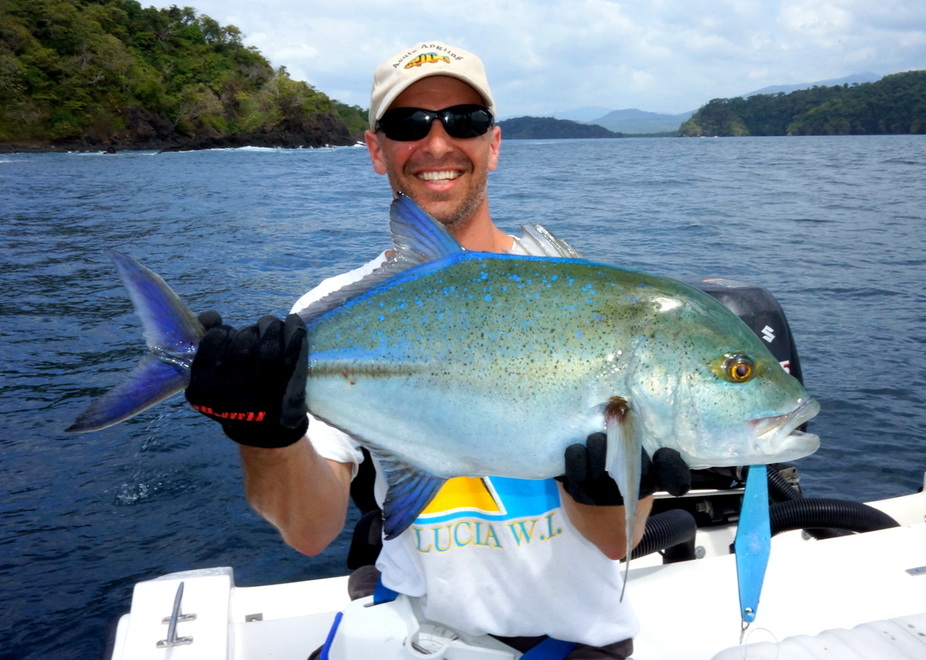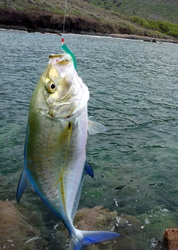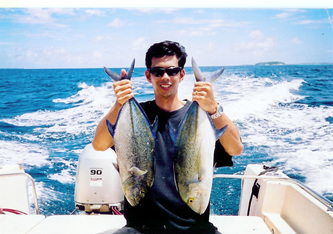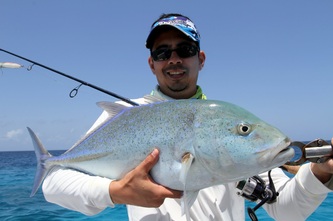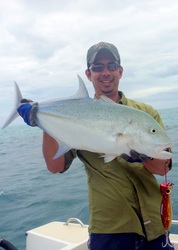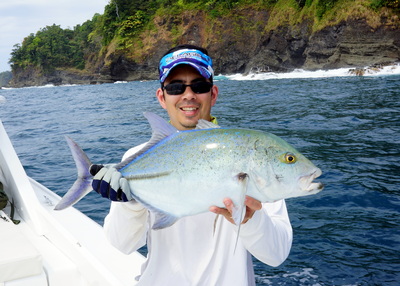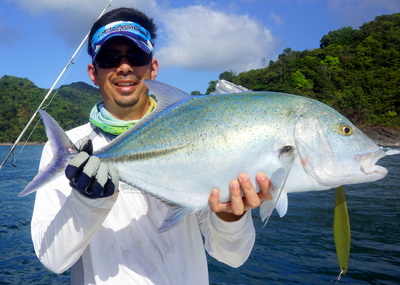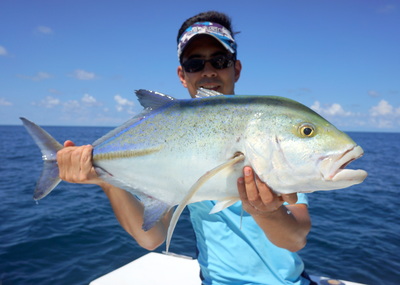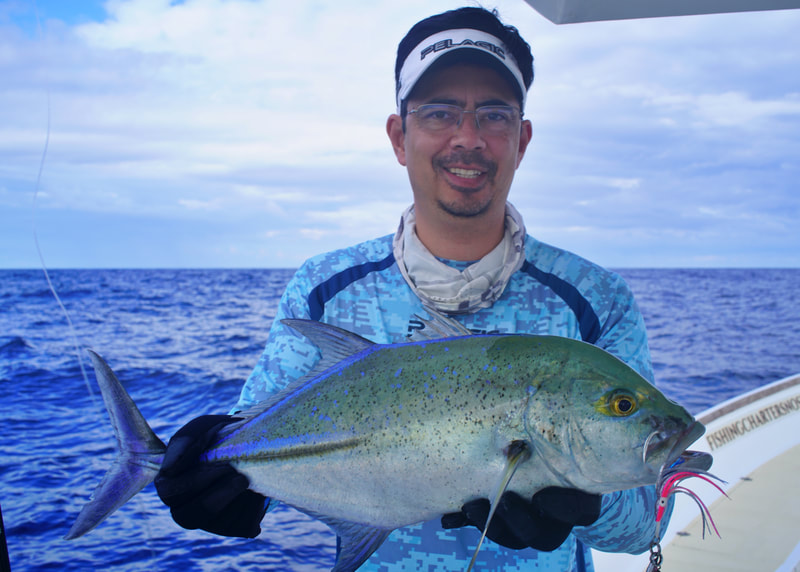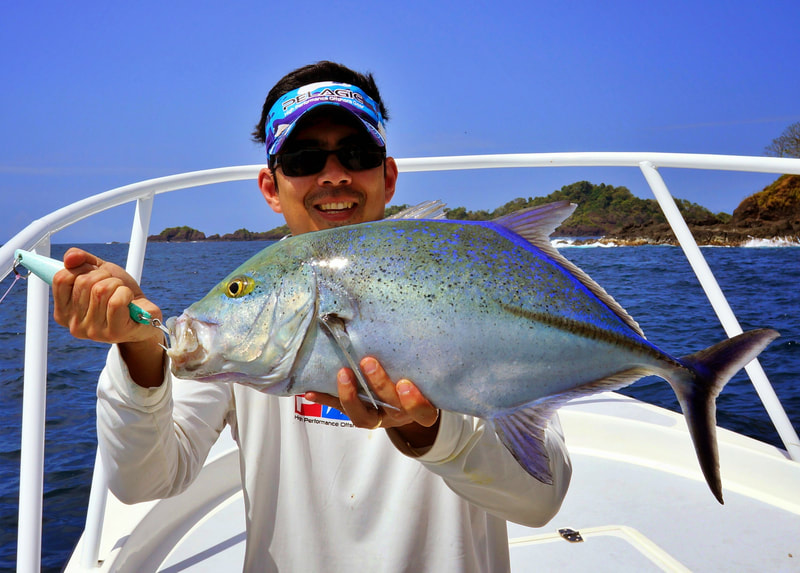Bluefin Trevally
Caranx melampygus
Home
Other Species
Bluefin Trevally Description
Bluefin Trevally (called 'Omilu in Hawaii) are one of the many tropical sportfish whose beautiful colors are rarely done justice in photos. They have amazing electric blue spots and lines that light up like a neon sign when they are excited. I spent a lot of time chasing small ones in my youth in Hawaii, as they are often caught in shallow tropical reef areas. They are an aggressive fish that puts up quite a fight; when people first pull them up they are often surprised at how small they end up being compared to how hard the fight was. They are one of the strongest pound for pound fish in the world.
As an example of their aggression, I once had a Bluefin Trevally in the Marshall Islands race up, grab my popper, pull the rear treble hooks out, swim around around, grab it again, and pull the middle trebles out. It then swam around with two sets of hooks hanging out of its mouth trying to find where the lure disappeared to.
If Bluefin Trevally got to the same size as some other Jacks such as the Giant Trevally they would be a terror on all but the heaviest of tackle and a boon to local tackle stores. However, 20lbs is a huge one and anything over 10lbs is a pretty big fish most places. I know people eat them but I have no idea how they taste.
Here is a video I made of my trip to the Great Barrier Reef which includes some Bluefin Trevally: CLICK HERE
Bluefin Trevally Pound for Pound Fight Rating - 8.5 out of 10 on the Saltwater Scale
Bluefin Trevally, like all Trevally, are extremely strong on a pound for pound basis. I'm consistently surprised that, after a huge battle, a relatively small Bluefin comes to the boat. They punch way above their weight. I've only been spooled and broken off a handful of times, and one of them was a 20lb Bluefin Trevally. They don't always head straight for the rocks like a snapper, but they will opportunistically break you off if they can in the reef.
Bluefin Trevally Culinary Rating - Medium
Unlike many members of the Jack family, they are actually pretty tasty to eat. I'm not sure why that is, but they don't have the bloody flesh of the Jack Crevalle. Instead, they have tasty white meat. In a few areas they have been implicated in ciguatera poisoning cases, so don't eat large ones in areas with ciguatera.
Bluefin Trevally Tackle
You should be able to land pretty much any Bluefin Trevally on 50lb braid and a heavy baitcasting or spinning outfit. Make sure you pull hard to get them away from the reefs where they live. They don't usually immediately go under rocks like Snapper or Grouper, but they sometimes will cut you off. I go armed with a Daiwa Saltiga spinning reel. For the small ones near shore, you could use a Daiwa Certate reel with a long spinning rod for long casts. Click here for tackle recommendations.
Bluefin Trevally Techniques
Bluefin Trevally readily eat both bait and lures, but I have caught most of mine on lures. This might be one of those fish for which lures consistently work better than bait.
Caranx melampygus
Home
Other Species
Bluefin Trevally Description
Bluefin Trevally (called 'Omilu in Hawaii) are one of the many tropical sportfish whose beautiful colors are rarely done justice in photos. They have amazing electric blue spots and lines that light up like a neon sign when they are excited. I spent a lot of time chasing small ones in my youth in Hawaii, as they are often caught in shallow tropical reef areas. They are an aggressive fish that puts up quite a fight; when people first pull them up they are often surprised at how small they end up being compared to how hard the fight was. They are one of the strongest pound for pound fish in the world.
As an example of their aggression, I once had a Bluefin Trevally in the Marshall Islands race up, grab my popper, pull the rear treble hooks out, swim around around, grab it again, and pull the middle trebles out. It then swam around with two sets of hooks hanging out of its mouth trying to find where the lure disappeared to.
If Bluefin Trevally got to the same size as some other Jacks such as the Giant Trevally they would be a terror on all but the heaviest of tackle and a boon to local tackle stores. However, 20lbs is a huge one and anything over 10lbs is a pretty big fish most places. I know people eat them but I have no idea how they taste.
Here is a video I made of my trip to the Great Barrier Reef which includes some Bluefin Trevally: CLICK HERE
Bluefin Trevally Pound for Pound Fight Rating - 8.5 out of 10 on the Saltwater Scale
Bluefin Trevally, like all Trevally, are extremely strong on a pound for pound basis. I'm consistently surprised that, after a huge battle, a relatively small Bluefin comes to the boat. They punch way above their weight. I've only been spooled and broken off a handful of times, and one of them was a 20lb Bluefin Trevally. They don't always head straight for the rocks like a snapper, but they will opportunistically break you off if they can in the reef.
Bluefin Trevally Culinary Rating - Medium
Unlike many members of the Jack family, they are actually pretty tasty to eat. I'm not sure why that is, but they don't have the bloody flesh of the Jack Crevalle. Instead, they have tasty white meat. In a few areas they have been implicated in ciguatera poisoning cases, so don't eat large ones in areas with ciguatera.
Bluefin Trevally Tackle
You should be able to land pretty much any Bluefin Trevally on 50lb braid and a heavy baitcasting or spinning outfit. Make sure you pull hard to get them away from the reefs where they live. They don't usually immediately go under rocks like Snapper or Grouper, but they sometimes will cut you off. I go armed with a Daiwa Saltiga spinning reel. For the small ones near shore, you could use a Daiwa Certate reel with a long spinning rod for long casts. Click here for tackle recommendations.
Bluefin Trevally Techniques
Bluefin Trevally readily eat both bait and lures, but I have caught most of mine on lures. This might be one of those fish for which lures consistently work better than bait.
Bluefin Trevally Lures
For larger fish, usually found farther from shore, large poppers and jerkbaits will work well. Fish them fast; Bluefin Trevally like to chase things and will have no interest in a slow moving lure. Their strike is violent and makes you think you have a much larger fish on at first. In Panama, I have had great success with surface iron jigs such as those made by Tady as shown in some of the photos on this page. Cast them over submerged rocks and retrieve them steadily so that they swing back and forth until they get hammered. I have not seen this tried anywhere but Panama, but it sure works well there.
For smaller Bluefin Trevally, I really like to use a clear plastic bobber, fill it with water, and then use a plastic strip about 30” past the bobber. You cast this as far as you can and immediately start reeling it in quickly while popping the rod tip every few seconds. This causes the plastic bobber to splash water and attracts the Bluefin Trevally, which come to investigate the commotion and then inhale the plastic strip. Instead of a plastic strip, you can also substitute any number of saltwater streamer flies, which work well and are light. This technique works on many types of Trevally as well as other reef fish. It is a surface technique so you can cast right over the top of a reef and start ripping it back. Of course, if something bites on the far side of the reef you can pretty much kiss your tackle goodbye and get ready to retie. Your leader must be as heavy as you can manage while still giving nice action to the plastic strip. I haven't been able to go heavier than 30lbs. A 5lb Bluefin Trevally will give you a real run for your money on this rig.
Often you will find that fish attack the bobber, so you can attach a treble hook to it with a split ring and catch fish on the bobber as well as the plastic strip. If you want to get fancy you can also attach a red bead to the line ahead of the plastic strip. For the strips I like clear with various colors of glitter and aqua green. This technique is one of my favorites because a) it is not used in many places outside Hawaii and b) you can see the fish come up to chase the lure. For aggressive fish this technique works wonders. It is very effective from shore if you don't have access to a boat.
Bluefin Trevally Baits
Bluefin Trevally can be caught on a variety of live baits such as baitfish or dead baits such as octopus or shrimp. No fancy rigs are needed. I have caught very few on bait so I can’t comment too much on this though. In Hawaii live juvenile goatfish (called 'oama in Hawaiian) work great.
Where to get the big Bluefin Trevally
Panama’s Pacific Coast has some big ones. Most South Pacific reefs will hold some nice ones. New Caledonia and the Great Barrier Reef are good bets.
Other Bluefin Trevally Resources
The above barely scratches the surface on how to catch Bluefin Trevally. The resources below will provide a wealth of information:
www.nomadsportfishing.com.au is an excellent source to catch these guys in Australia.
Cebaco Bay Sportfishing Club offers excellent trips in an area that has a lot of big ones. The current all tackle world record is from an area these guys fish.
For larger fish, usually found farther from shore, large poppers and jerkbaits will work well. Fish them fast; Bluefin Trevally like to chase things and will have no interest in a slow moving lure. Their strike is violent and makes you think you have a much larger fish on at first. In Panama, I have had great success with surface iron jigs such as those made by Tady as shown in some of the photos on this page. Cast them over submerged rocks and retrieve them steadily so that they swing back and forth until they get hammered. I have not seen this tried anywhere but Panama, but it sure works well there.
For smaller Bluefin Trevally, I really like to use a clear plastic bobber, fill it with water, and then use a plastic strip about 30” past the bobber. You cast this as far as you can and immediately start reeling it in quickly while popping the rod tip every few seconds. This causes the plastic bobber to splash water and attracts the Bluefin Trevally, which come to investigate the commotion and then inhale the plastic strip. Instead of a plastic strip, you can also substitute any number of saltwater streamer flies, which work well and are light. This technique works on many types of Trevally as well as other reef fish. It is a surface technique so you can cast right over the top of a reef and start ripping it back. Of course, if something bites on the far side of the reef you can pretty much kiss your tackle goodbye and get ready to retie. Your leader must be as heavy as you can manage while still giving nice action to the plastic strip. I haven't been able to go heavier than 30lbs. A 5lb Bluefin Trevally will give you a real run for your money on this rig.
Often you will find that fish attack the bobber, so you can attach a treble hook to it with a split ring and catch fish on the bobber as well as the plastic strip. If you want to get fancy you can also attach a red bead to the line ahead of the plastic strip. For the strips I like clear with various colors of glitter and aqua green. This technique is one of my favorites because a) it is not used in many places outside Hawaii and b) you can see the fish come up to chase the lure. For aggressive fish this technique works wonders. It is very effective from shore if you don't have access to a boat.
Bluefin Trevally Baits
Bluefin Trevally can be caught on a variety of live baits such as baitfish or dead baits such as octopus or shrimp. No fancy rigs are needed. I have caught very few on bait so I can’t comment too much on this though. In Hawaii live juvenile goatfish (called 'oama in Hawaiian) work great.
Where to get the big Bluefin Trevally
Panama’s Pacific Coast has some big ones. Most South Pacific reefs will hold some nice ones. New Caledonia and the Great Barrier Reef are good bets.
Other Bluefin Trevally Resources
The above barely scratches the surface on how to catch Bluefin Trevally. The resources below will provide a wealth of information:
www.nomadsportfishing.com.au is an excellent source to catch these guys in Australia.
Cebaco Bay Sportfishing Club offers excellent trips in an area that has a lot of big ones. The current all tackle world record is from an area these guys fish.
